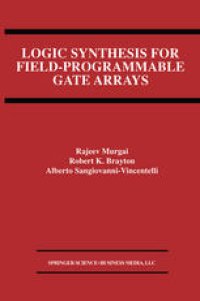
Ebook: Logic Synthesis for Field-Programmable Gate Arrays
- Tags: Circuits and Systems, Electrical Engineering, Computer-Aided Engineering (CAD CAE) and Design
- Series: The Springer International Series in Engineering and Computer Science 324
- Year: 1995
- Publisher: Springer US
- Edition: 1
- Language: English
- pdf
Short turnaround has become critical in the design of electronic systems. Software- programmable components such as microprocessors and digital signal processors have been used extensively in such systems since they allow rapid design revisions. However, the inherent performance limitations of software-programmable systems mean that they are inadequate for high-performance designs. Designers thus turned to gate arrays as a solution. User-programmable gate arrays (field-programmable gate arrays, FPGAs) have recently emerged and are changing the way electronic systems are designed and implemented. The growing complexity of the logic circuits that can be packed onto an FPGA chip means that it has become important to have automatic synthesis tools that implement logic functions on these architectures. Logic Synthesis for Field-Programmable Gate Arrays describes logic synthesis for both look-up table (LUT) and multiplexor-based architectures, with a balanced presentation of existing techniques together with algorithms and the system developed by the authors.
Audience: A useful reference for VLSI designers, developers of computer-aided design tools, and anyone involved in or with FPGAs.
Short turnaround has become critical in the design of electronic systems. Software- programmable components such as microprocessors and digital signal processors have been used extensively in such systems since they allow rapid design revisions. However, the inherent performance limitations of software-programmable systems mean that they are inadequate for high-performance designs. Designers thus turned to gate arrays as a solution. User-programmable gate arrays (field-programmable gate arrays, FPGAs) have recently emerged and are changing the way electronic systems are designed and implemented. The growing complexity of the logic circuits that can be packed onto an FPGA chip means that it has become important to have automatic synthesis tools that implement logic functions on these architectures. Logic Synthesis for Field-Programmable Gate Arrays describes logic synthesis for both look-up table (LUT) and multiplexor-based architectures, with a balanced presentation of existing techniques together with algorithms and the system developed by the authors.
Audience: A useful reference for VLSI designers, developers of computer-aided design tools, and anyone involved in or with FPGAs.
Short turnaround has become critical in the design of electronic systems. Software- programmable components such as microprocessors and digital signal processors have been used extensively in such systems since they allow rapid design revisions. However, the inherent performance limitations of software-programmable systems mean that they are inadequate for high-performance designs. Designers thus turned to gate arrays as a solution. User-programmable gate arrays (field-programmable gate arrays, FPGAs) have recently emerged and are changing the way electronic systems are designed and implemented. The growing complexity of the logic circuits that can be packed onto an FPGA chip means that it has become important to have automatic synthesis tools that implement logic functions on these architectures. Logic Synthesis for Field-Programmable Gate Arrays describes logic synthesis for both look-up table (LUT) and multiplexor-based architectures, with a balanced presentation of existing techniques together with algorithms and the system developed by the authors.
Audience: A useful reference for VLSI designers, developers of computer-aided design tools, and anyone involved in or with FPGAs.
Content:
Front Matter....Pages i-xvii
Front Matter....Pages 1-1
Introduction....Pages 3-17
Background....Pages 19-47
Front Matter....Pages 49-49
Mapping Combinational Logic....Pages 51-176
Logic Optimization....Pages 177-193
Complexity Issues....Pages 195-254
Mapping Sequential Logic....Pages 255-297
Performance Directed Synthesis....Pages 299-321
Front Matter....Pages 323-323
Mapping Combinational Logic....Pages 325-395
Front Matter....Pages 397-397
Conclusions....Pages 399-407
Back Matter....Pages 409-427
Short turnaround has become critical in the design of electronic systems. Software- programmable components such as microprocessors and digital signal processors have been used extensively in such systems since they allow rapid design revisions. However, the inherent performance limitations of software-programmable systems mean that they are inadequate for high-performance designs. Designers thus turned to gate arrays as a solution. User-programmable gate arrays (field-programmable gate arrays, FPGAs) have recently emerged and are changing the way electronic systems are designed and implemented. The growing complexity of the logic circuits that can be packed onto an FPGA chip means that it has become important to have automatic synthesis tools that implement logic functions on these architectures. Logic Synthesis for Field-Programmable Gate Arrays describes logic synthesis for both look-up table (LUT) and multiplexor-based architectures, with a balanced presentation of existing techniques together with algorithms and the system developed by the authors.
Audience: A useful reference for VLSI designers, developers of computer-aided design tools, and anyone involved in or with FPGAs.
Content:
Front Matter....Pages i-xvii
Front Matter....Pages 1-1
Introduction....Pages 3-17
Background....Pages 19-47
Front Matter....Pages 49-49
Mapping Combinational Logic....Pages 51-176
Logic Optimization....Pages 177-193
Complexity Issues....Pages 195-254
Mapping Sequential Logic....Pages 255-297
Performance Directed Synthesis....Pages 299-321
Front Matter....Pages 323-323
Mapping Combinational Logic....Pages 325-395
Front Matter....Pages 397-397
Conclusions....Pages 399-407
Back Matter....Pages 409-427
....